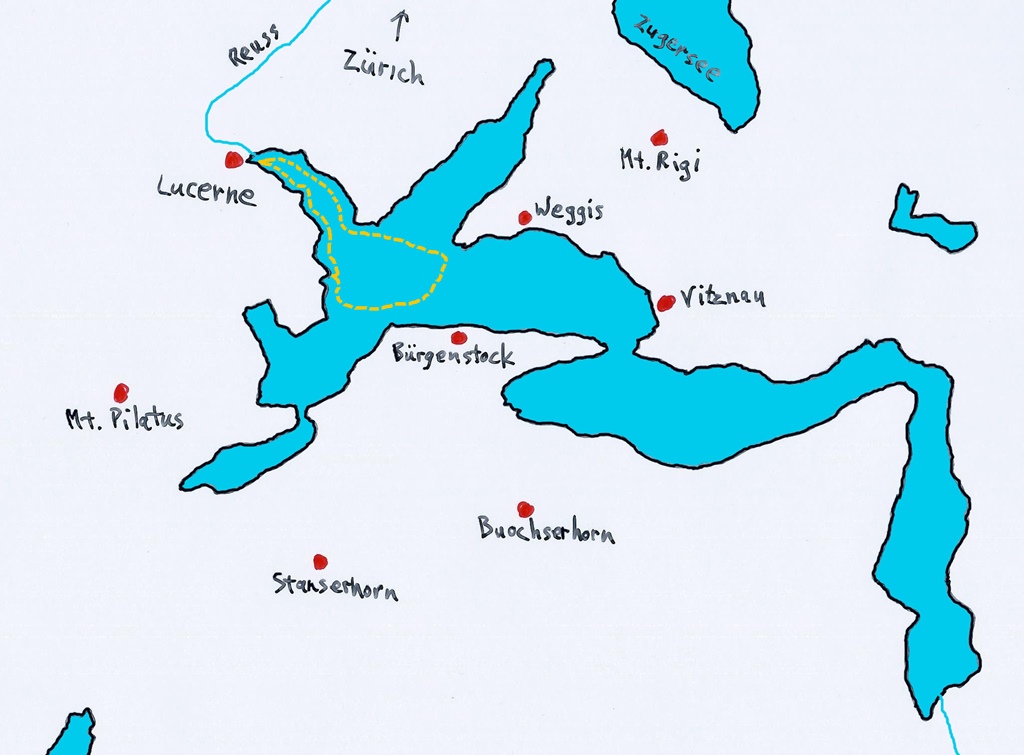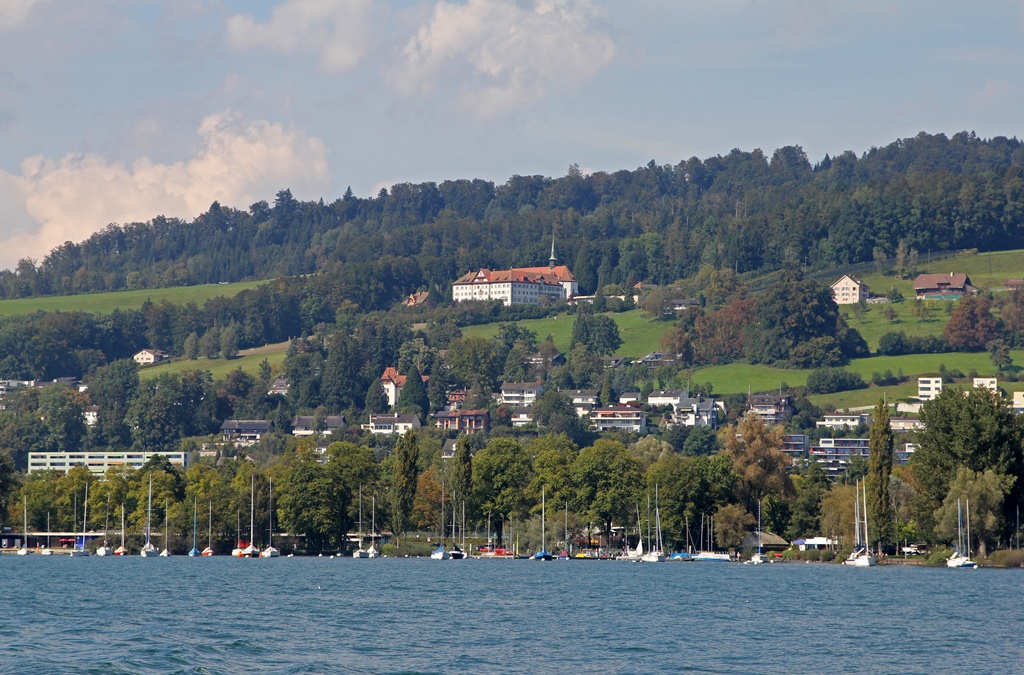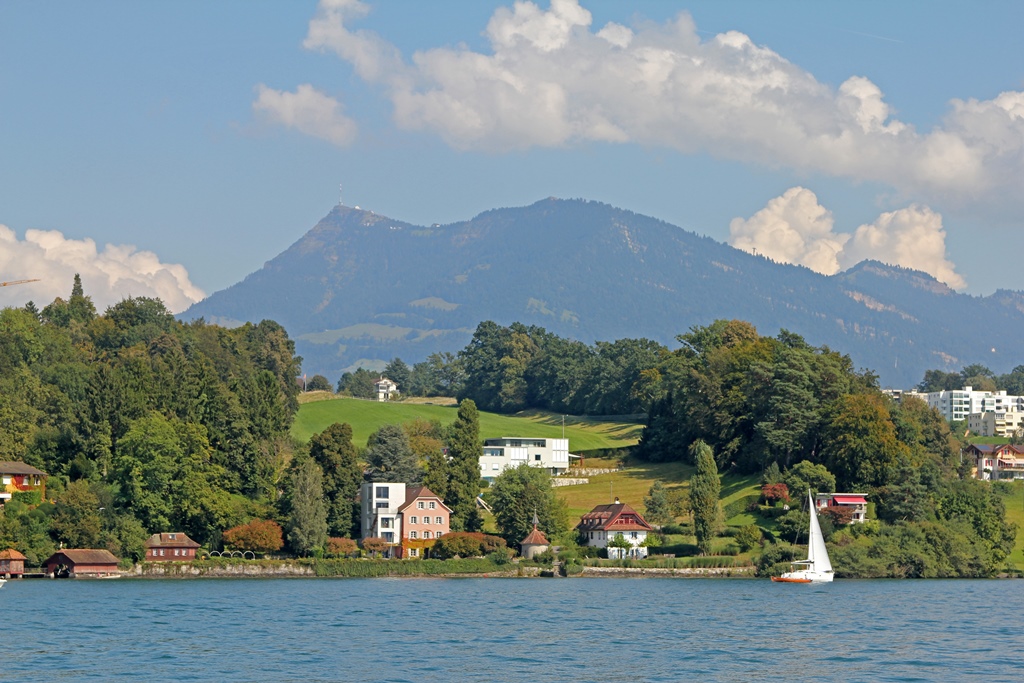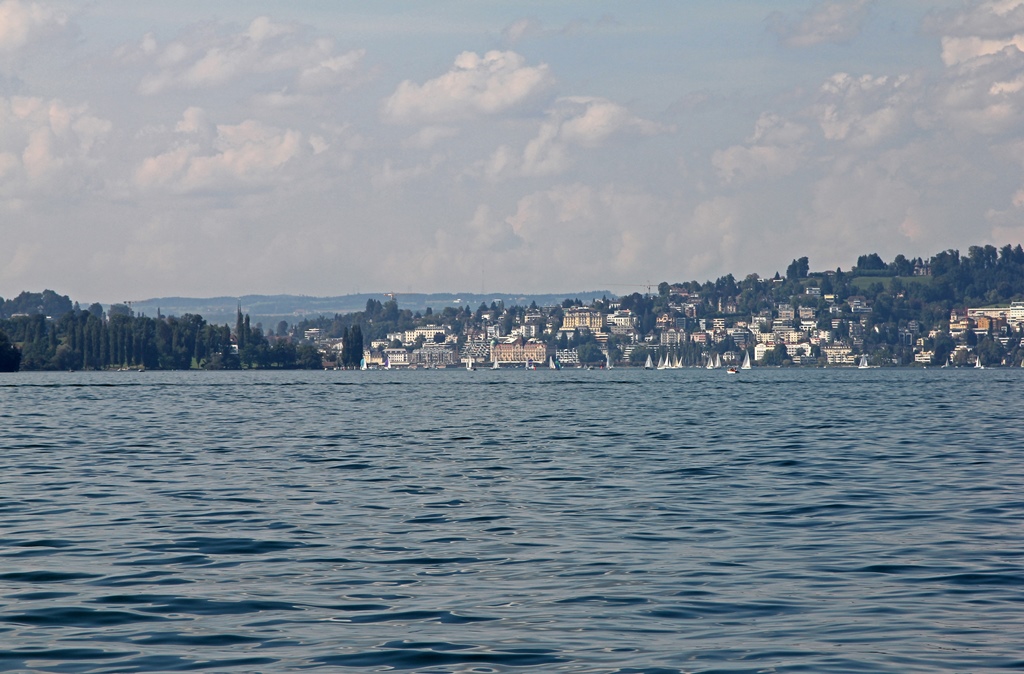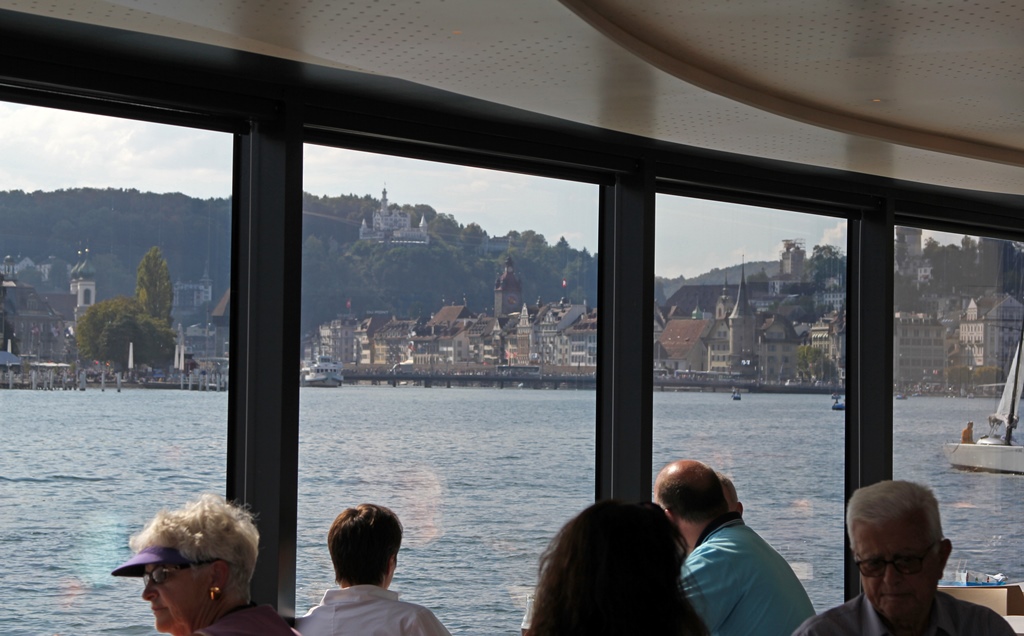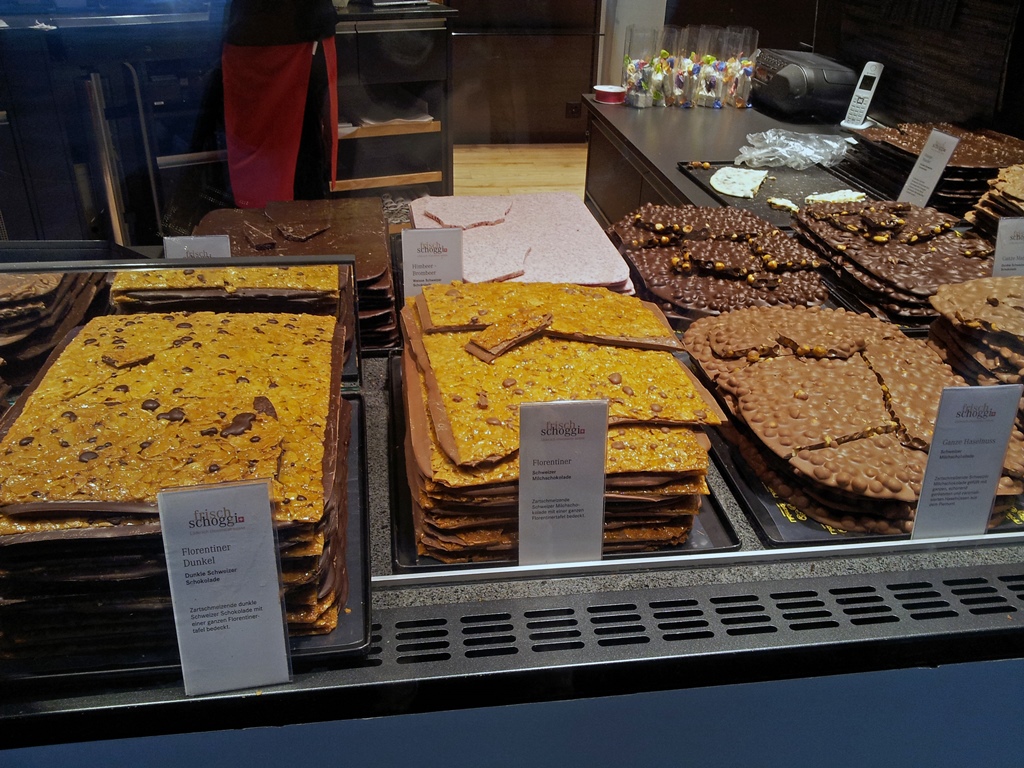As our boat glided eastward off the shore of Lucerne, we watched as the habitations
became less dense, soon threatening to give out altogether. We could not predict
when or if we would see civilization again. We looked ahead as best we could from
our position aft of the main cabin, and could see an approaching headland, beyond
which all was hidden from us. We could only guess at the unspeakable perils that
awaited us in the watery expanse on the other side. Our minds wandered to rocky
teeth, hungering to rip out the undersides of careless vessels, or to primeval
creatures of the deep, with flashing white fangs and as little regard for human
life as we have for the life of a mosquito. And there were mountains everywhere -
one landslide could raise a wall of water which would submerge our boat like a
child's toy, sending it and its occupants to depths from which it would never
emerge. It took all of our self-control to keep from crying out to the captain,
imploring him to turn back before it was too late!
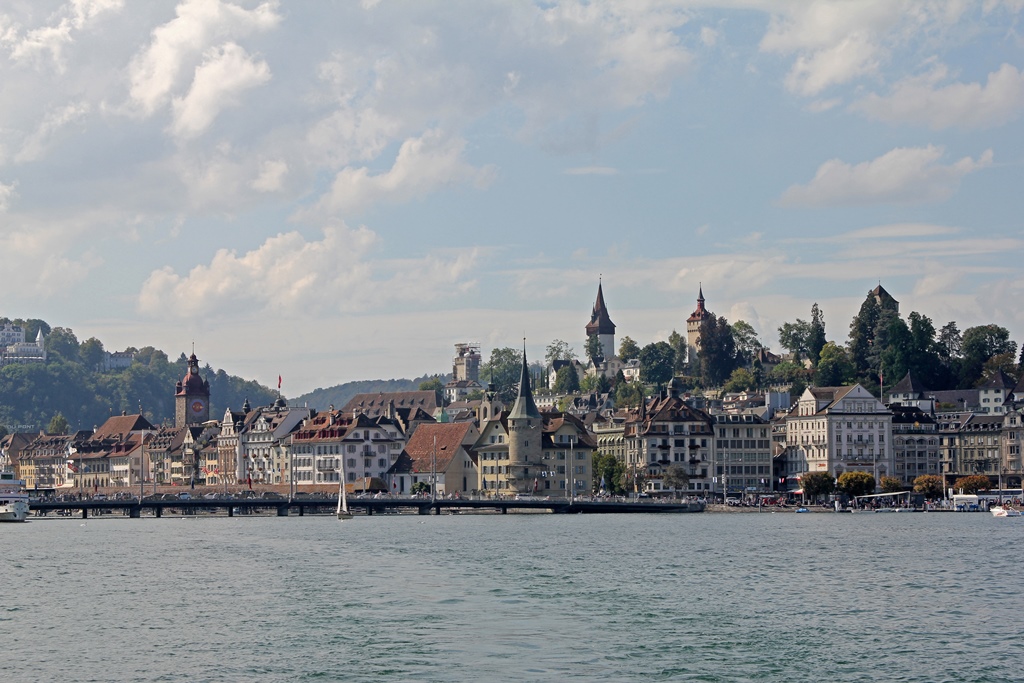
Lucerne North Bank from Tour Boat
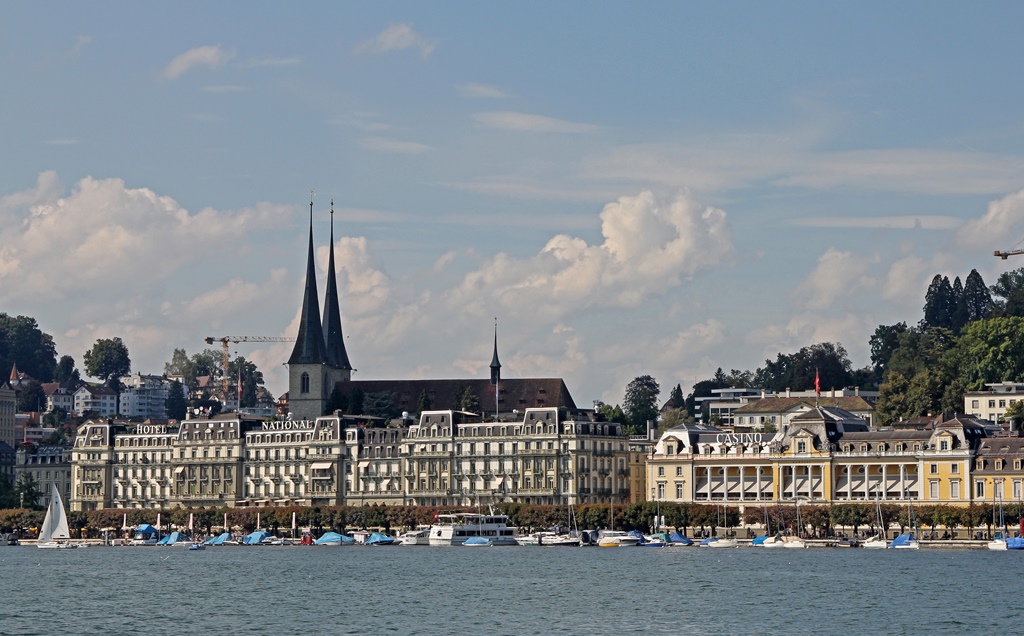
Hotel and Casino from Tour Boat

Boats and Lucerne Lakeshore
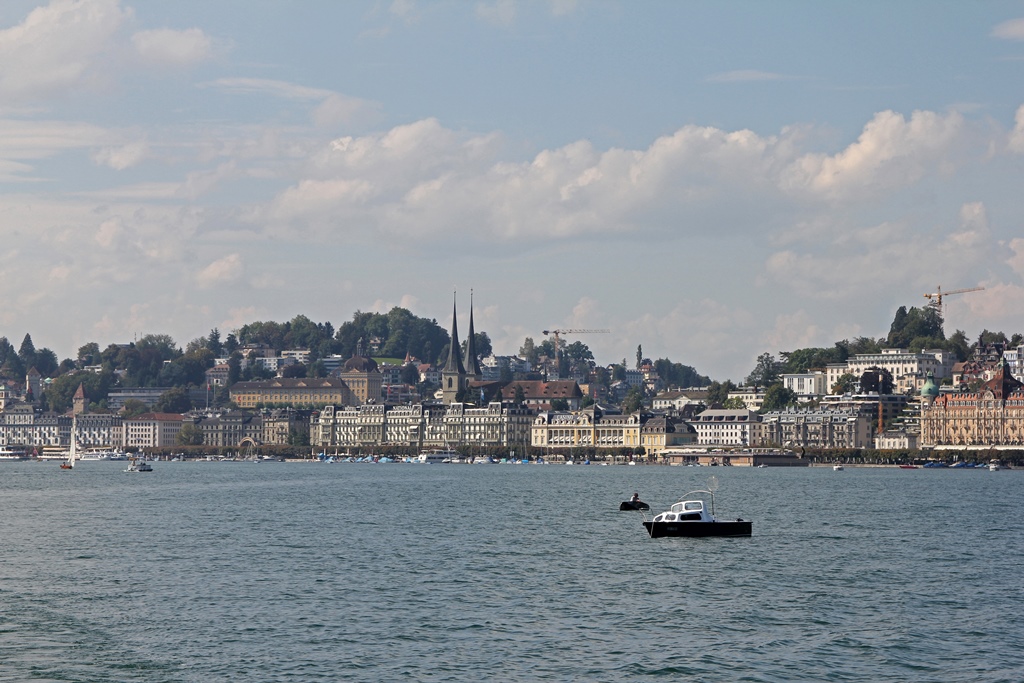
Lucerne Lakeshore
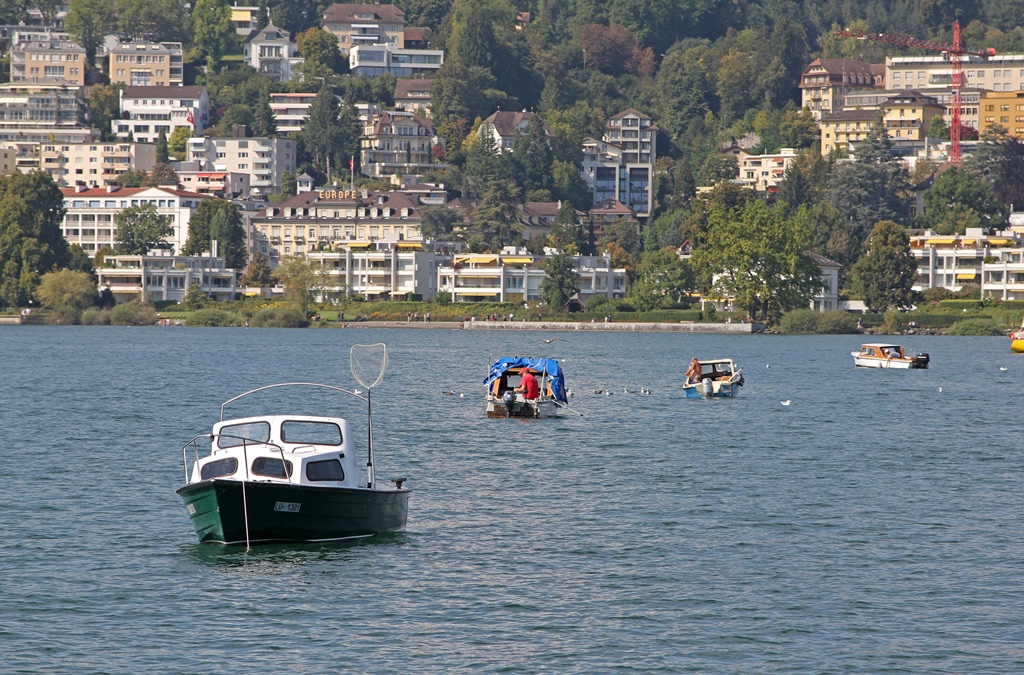
Small Boats and Grand Hotel Europe
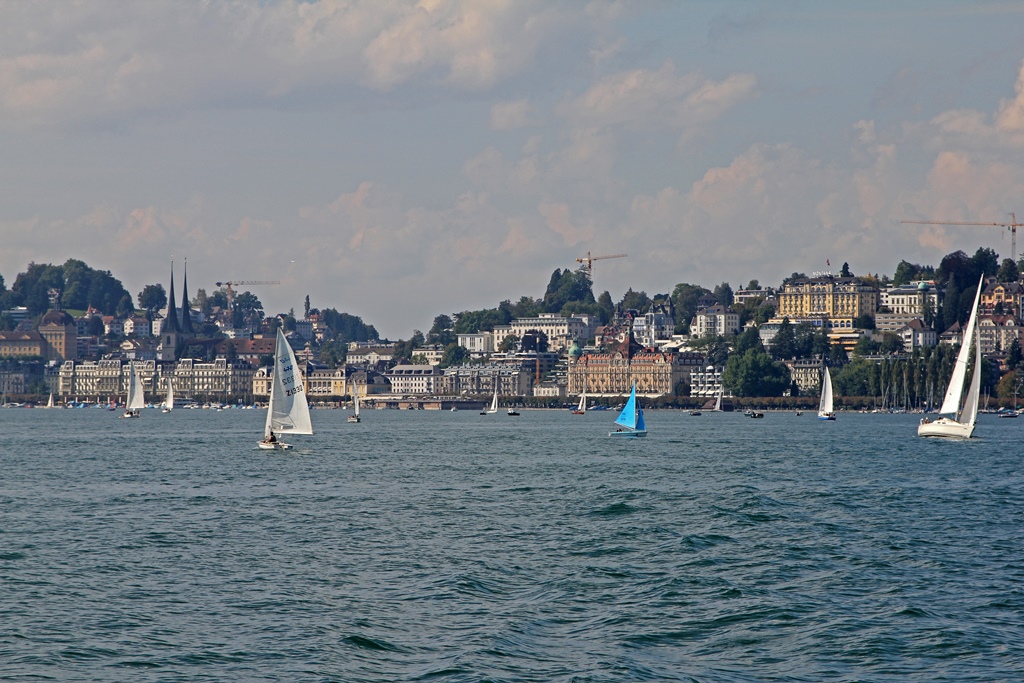
Lucerne and Sailboats
In retrospect, it's probably good that we didn't say anything. On the other side
of the headland there were more habitations, and in fact there are houses, resorts
and small towns all over Lake Lucerne's 90-mile lakeshore. All hazards are
undoubtedly mapped out to the centimeter, and there are almost certainly people
who make entire careers of studying the flora and fauna of the Swiss lakes, and
the geology of the surrounding mountains. And of course the boat's captain has
probably followed this route hundreds of times, and has no doubt seen all that
there is to see many times over. I could probably see your point of view if you
were to suggest that I've been overly dramatic. But it's a dramatic lake.
Lake Lucerne with Approximate Tour Route
Lake Lucerne, at 44 square miles, is the fifth-largest in Switzerland. It has
an average depth of 341 feet and a maximum depth of 702 feet. This depth does
not change, as the lake level is regulated through use of a "needle dam" on the
River Reuss in the city of Lucerne (see
the Lucerne page for a look at it).
This works because the Reuss is the only major outflow from the lake. It's also
an inflow, at the opposite end of the lake from Lucerne, and there are other
inflows as well. As you can see from the map, the lake's shape is anything but
regular. This naturally leads to people calling different parts of the lake by
different names. There are actually ten of these names. I won't go through all
of them, but I will mention the two sections on the route traversed by our tour
boat. These are the Luzernersee, the small "arm" of the lake with Lucerne
at its tip, and the Chrütztrichter, the area just outside the Luzernersee
which appears to be a "crossroads" of different lake extensions. Our tour route
would take us east from Lucerne, parallel to the north shore of the Luzernersee,
followed by a circle around the edge of the Chrütztrichter, and finally a return
to Lucerne by way of the Luzernersee's south shore. While this route only goes
into a small fraction of the lake (necessary because of the one-hour time
limitation), it's possible to see pretty well into the parts of the lake that
extend from the Chrütztrichter.
The full lake is called the Vierwaldstättersee in the local language,
meaning "Lake of the Four Forested Settlements", which would seem to be a much
more complicated name than "Lake Lucerne". Unfortunately, "Lake Lucerne" in
German is Luzernersee, and calling it by this name would lead to
confusion between Lucerne's little section of the lake and the whole enchilada.
The Vierwaldstättersee name has been used since the 16th Century, and reflects
the four Swiss cantons which shared the lakeshore at the time. One of the
cantons has split into two since that time, so one might think they'd have
updated the name to Fünfwaldstättersee, but they still use the old name.
I guess it's just one of those things.
The drama of Lake Lucerne comes from the mountains that surround it. Unlike a
lake like the Zürichsee (the sixth-largest in Switzerland), Lake Lucerne
has nearby mountains, some virtually at the shoreline, rising thousands of feet
above the level of the lake. I'll introduce some of them as they show up in the
photos.
The pictures above came from the north shore of the Luzernersee on our way
toward the Chrütztrichter. The following picture was taken along the same shore
and shows an apparent beach resort. With all of the surrounding mountains, one
has to wonder whether hypothermia is a hazard here. But the resort didn't seem
to be hurting for customers (though most of them didn't appear to actually be in
the water).
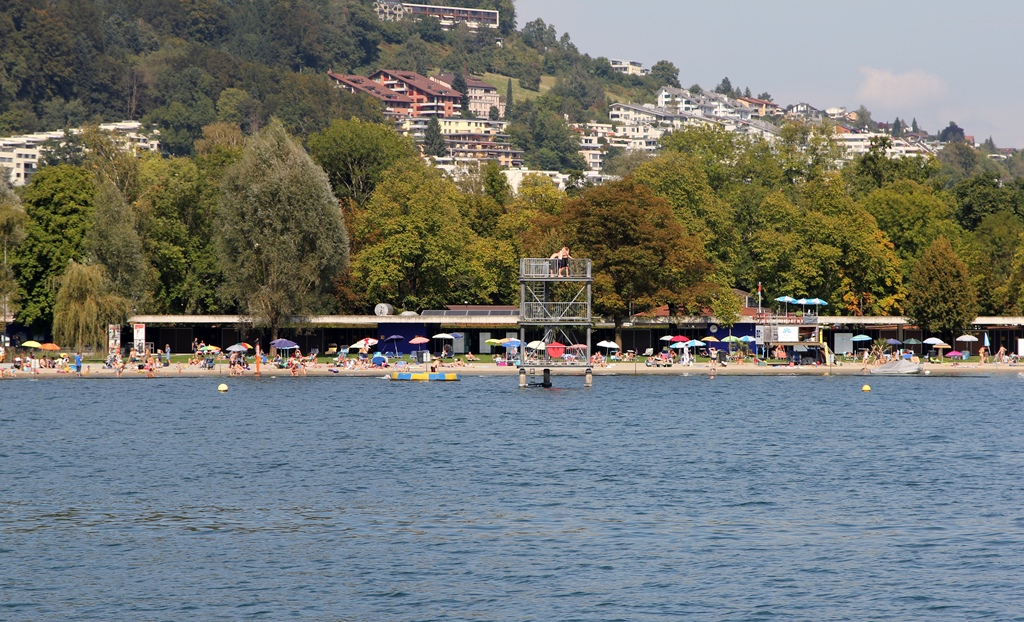
Beach Resort
A little farther on we saw an interesting-looking building on a hillside. This
turned out to be the Monastery of St. Anna, home to a community of Capuchin
nuns which has been there since 1904.
Das Kapuzinerinnen-Kloster St. Anna and Sailboats
Looking ahead and to the left, we had a nice view of the first major mountain we
would encounter, known as Mt. Rigi, or commonly "The Rigi". The Rigi is actually
a group of mountains, connected with each other in what's called a "mountain massif".
The highest peak, at about 5,900 feet, is called Rigi Kulm. The massif
parallels the entire section of the lake between the Chrütztrichter and the town of
Vitznau. This section is called the Vitznauer Bucht. The oldest mountain
railways in Europe can be found in this area. Mark Twain visited this area in the
late 1870's, and wrote about it in his book A Tramp Abroad.
Mt. Rigi
As we approached the headland that marked the end of the Luzernersee and
the start of the Chrütztrichter, we could see an interesting-looking building
hidden amongst the trees covering the headland. This is called the
Meggenhorn Castle, and it was built in 1868-70. It's now used as a tourist
attraction and reception venue.

Lake, Mt. Rigi, Meggenhorn Castle
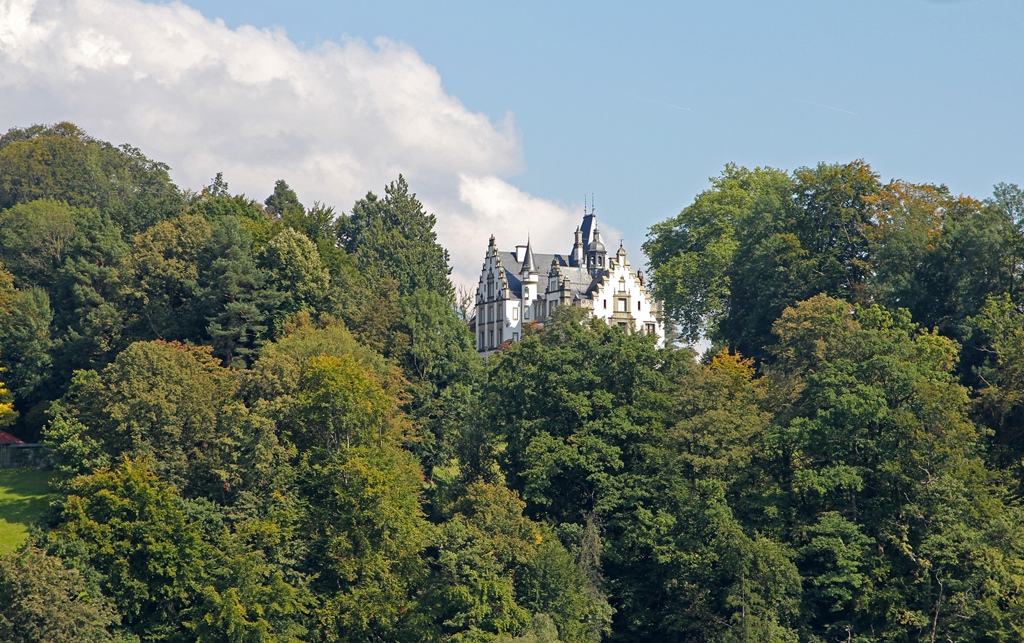
Meggenhorn Castle
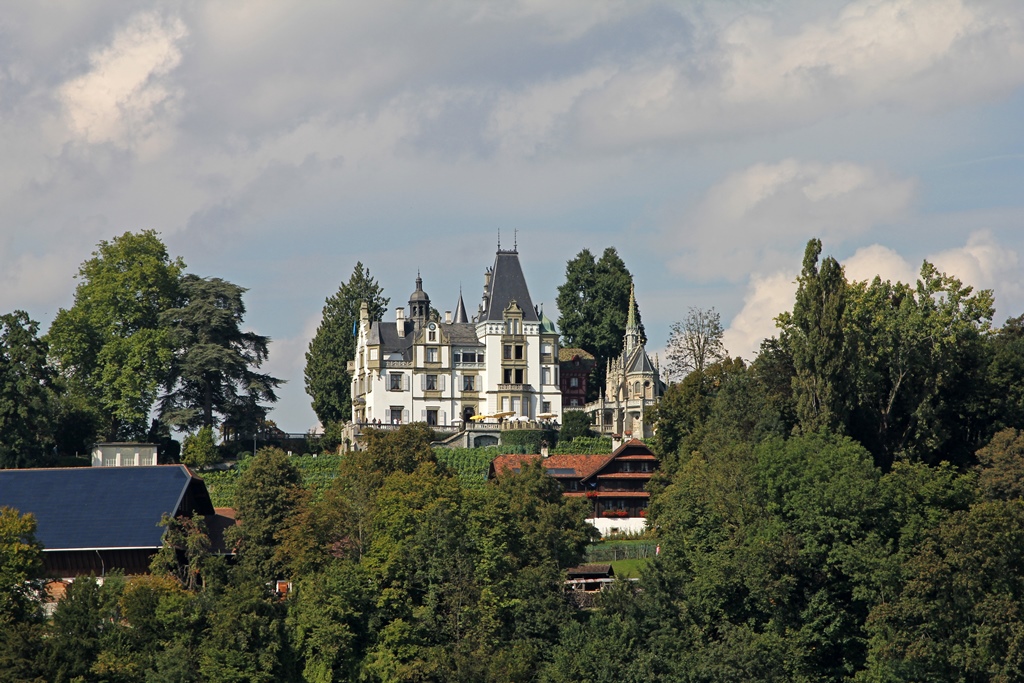
Meggenhorn Castle
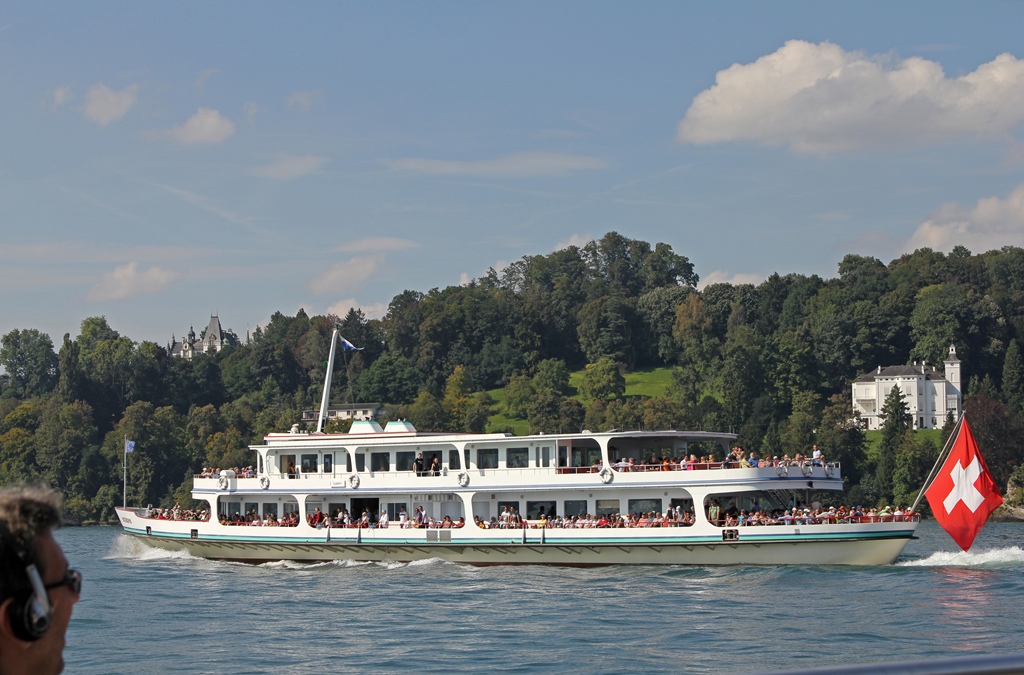
Tour Boat Europa
The boat continued across the Chrütztrichter, where another headland marked
the beginning of the Vitznauer Bucht. Largely concealed by vegetation and
the headland is a community of 4,000 called Weggis. We never got very close
to Weggis, making a right turn and leaving The Rigi astern well before entering
the Vitznauer Bucht. As we were camped out on the stern of the boat, this turn
gave us a pretty good view of the entire massif. And looking to port (left),
we had a nice view into the Vitznauer Bucht. At its far end we could see the
town of Vitznau, and above it a Swiss flag that some adventurous person had
painted on The Rigi's cliff face.
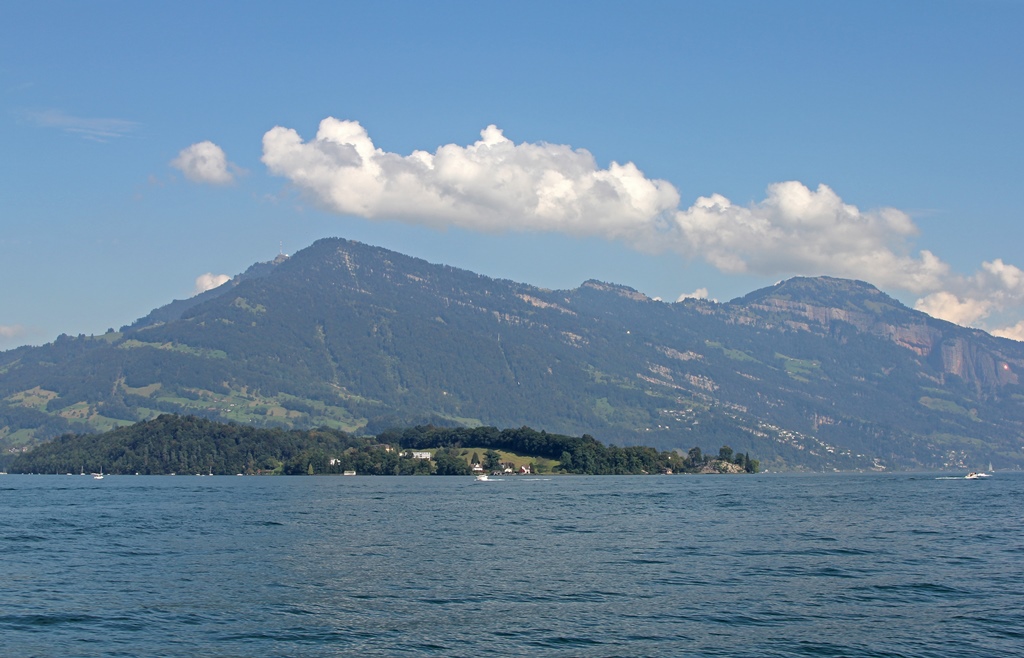
View Toward Weggis and The Rigi
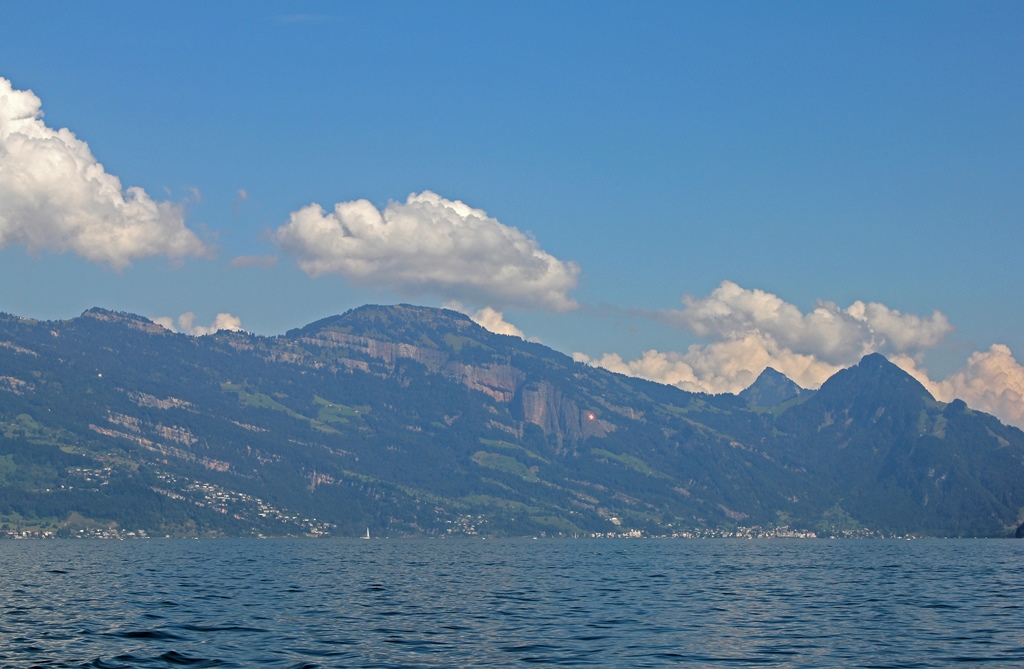
View Toward Vitznau
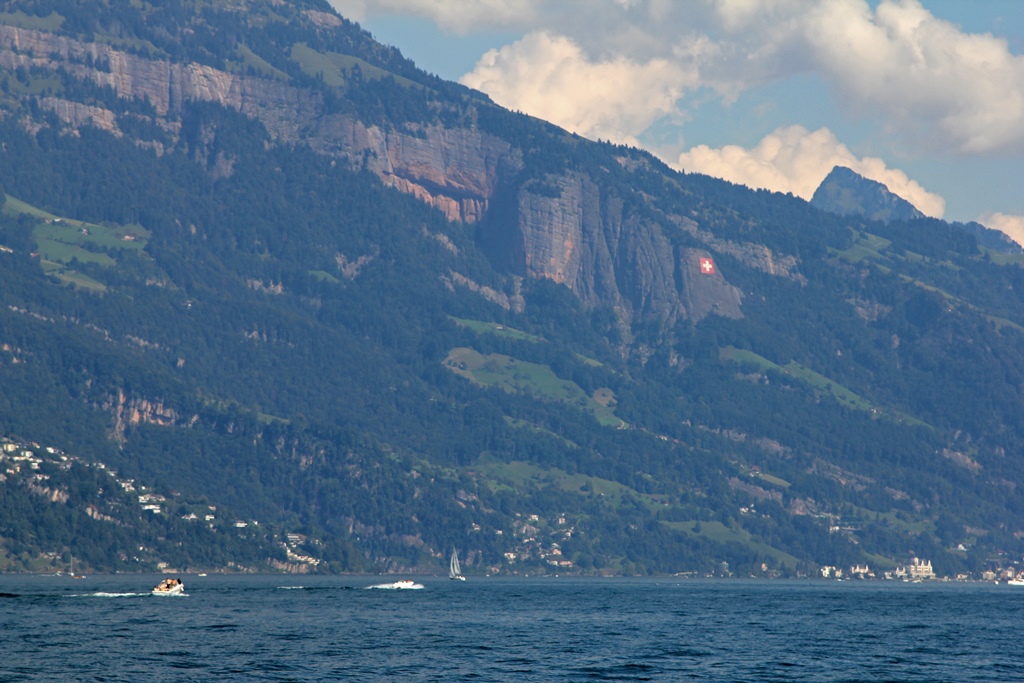
Swiss Cross Above Vitznau
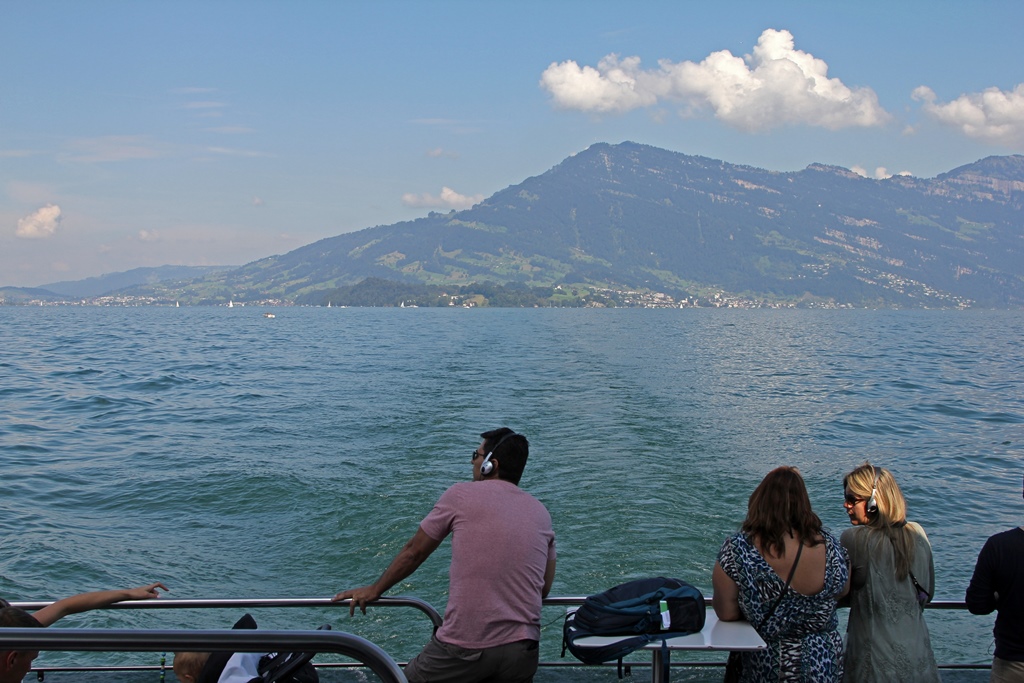
Leaving The Rigi
View into Vitznauer Bucht
South of Vitznau there's a narrow strait that connects the Vitznauer Bucht
with more of the lake, but we couldn't see the strait, as there was a mountain
in the way. This mountain, which extends along the entire south side of the
Vitznauer Bucht, is called the Bürgenstock. The Bürgenstock is mostly vertical
from shoreline to summit, but there is a grassy section along part of its base
which is considered to be a piece of Lucerne (known as an exclave) which has
been carved out of the neighboring canton of Nidwalden. The highest point of
the Bürgenstock, at 3,658 feet, is called the Hammetschwand. It's possible to
reach the Hammetschwand using something called the Hammetschwand Elevator,
which is an actual elevator that takes hikers the last 500 feet of the way up.
The first Elevator was built in 1905, and it remains the highest exterior
elevator in Europe. You can see it in some of the following pictures if you
view the high-resolution version and zoom in on the summit.
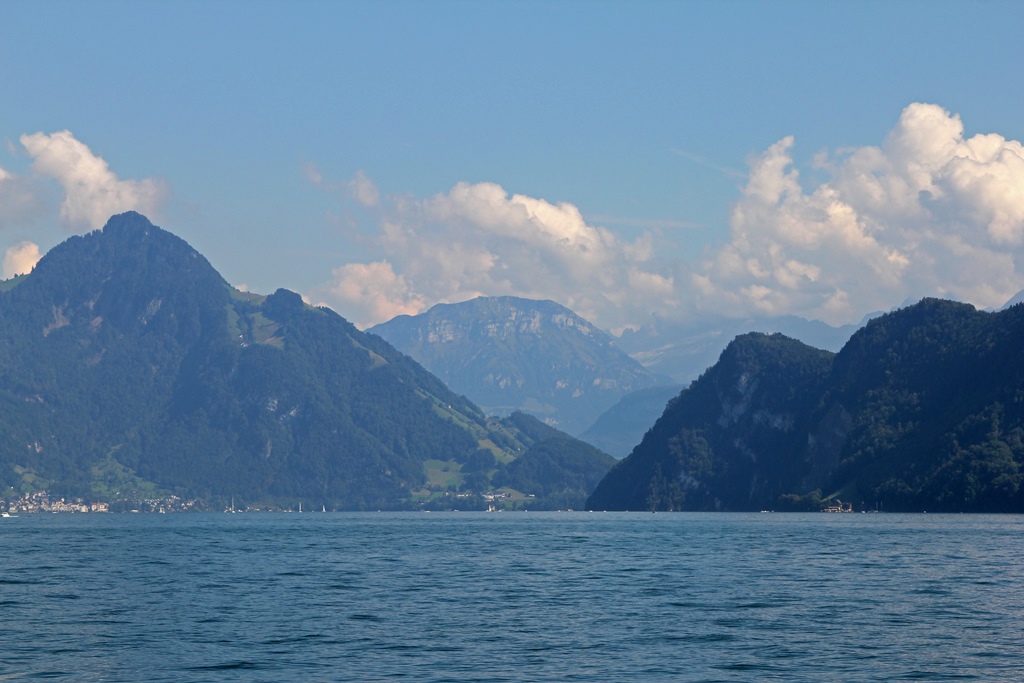
View South of Vitznau
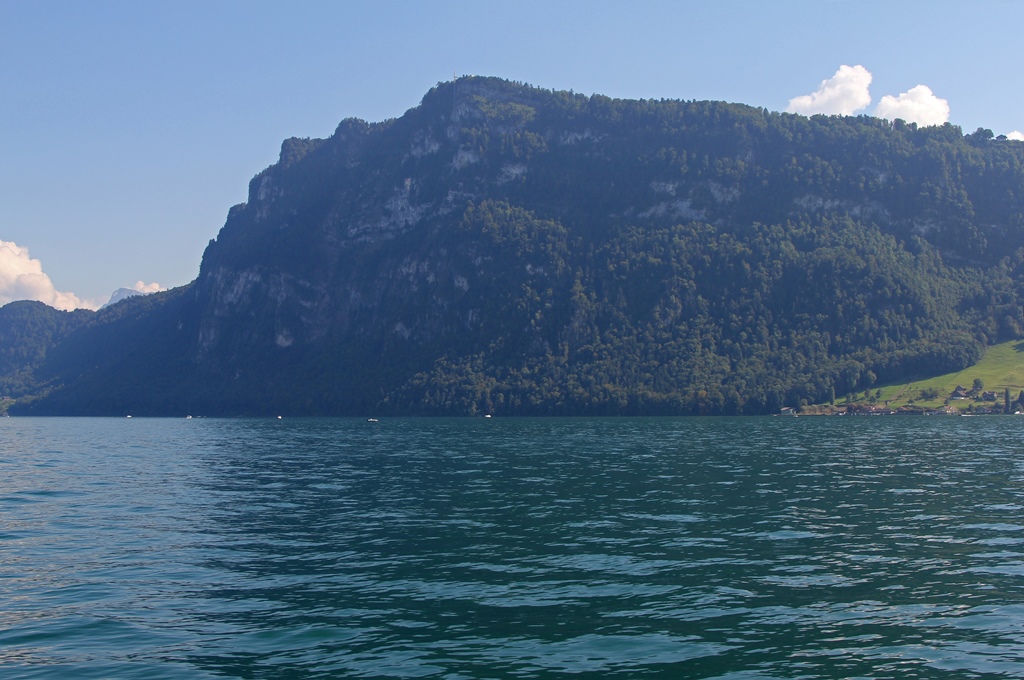
Bürgenstock
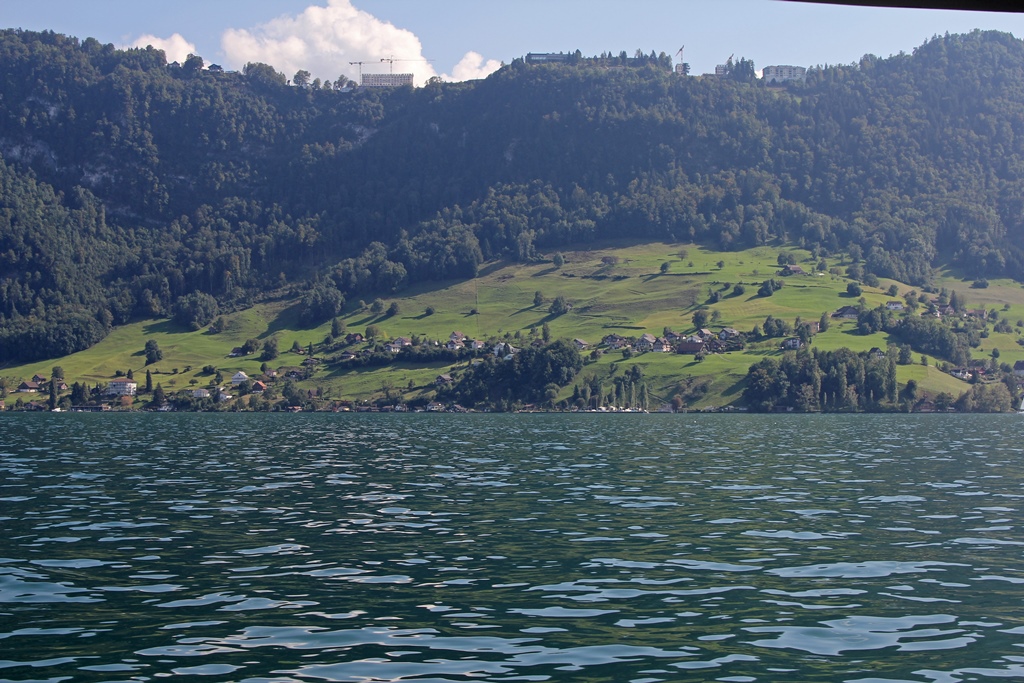
Lucerne Exclave and Bürgenstock

Bürgenstock and Lucerne Exclave
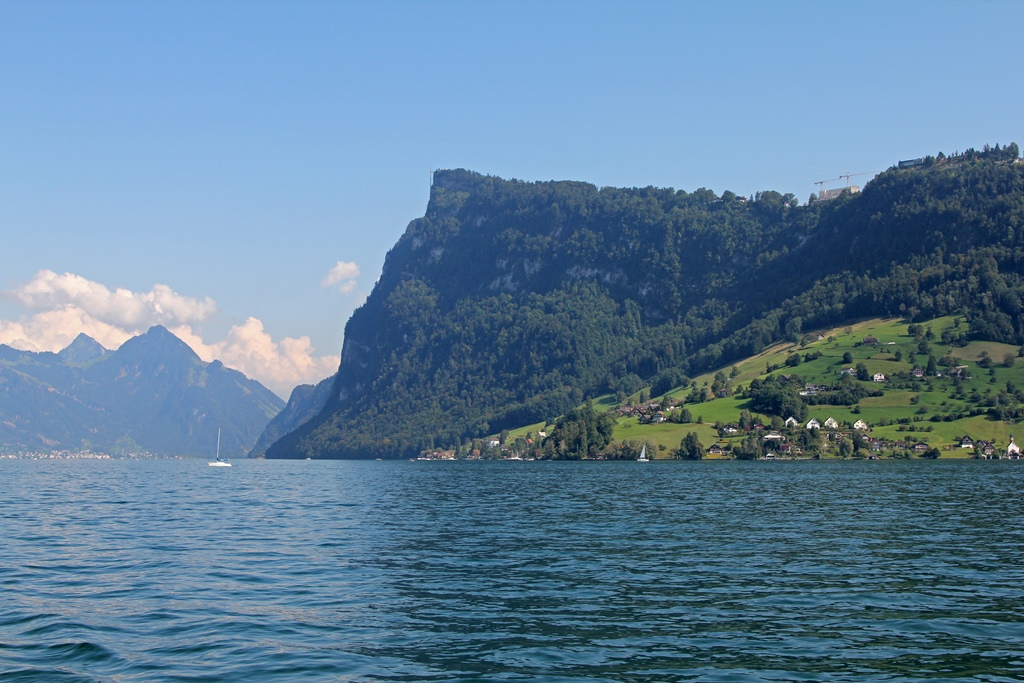
Bürgenstock and Lucerne Exclave
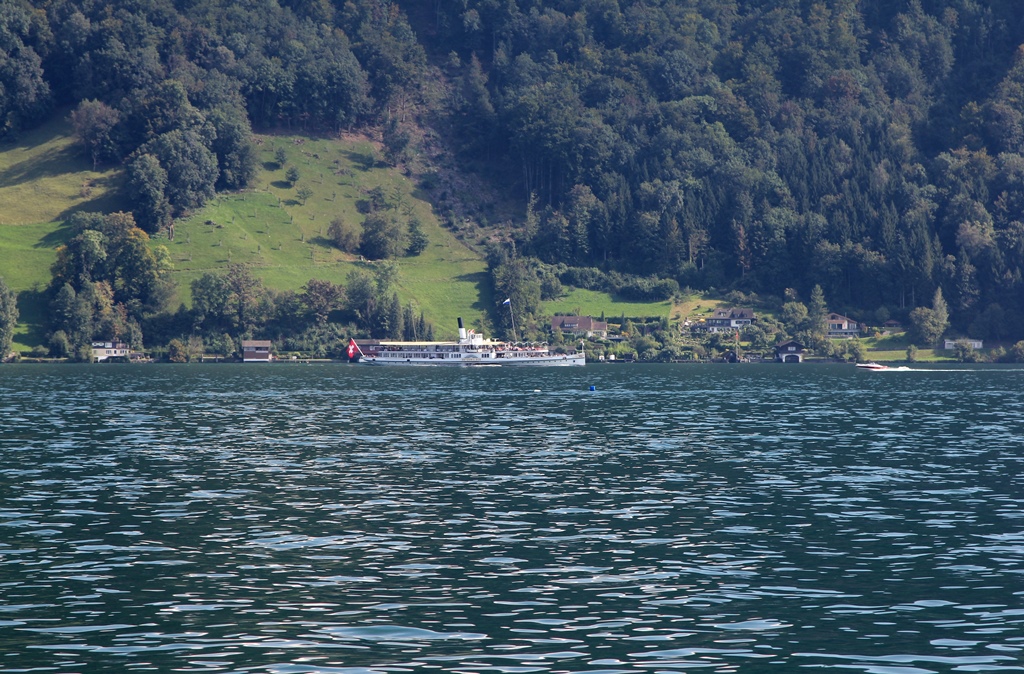
Tour Boat Unterwalden and Lucerne Exclave
We were headed directly for the Bürgenstock, but before getting too close, we
turned right again. At this point we started to head back west, and we were at
the farthest point of the tour from where we'd started. This turn took us across
the southern edge of the Chrütztrichter, from which we could see into a southern
extension of the lake. This extension is called the Stanser Trichter, and
on the Bürgenstock side of it we could see the town of Stansstad. Behind Stansstad
we could see another mountain, this one being the 6,227-foot Stanserhorn.
Lucerne from Across Lake
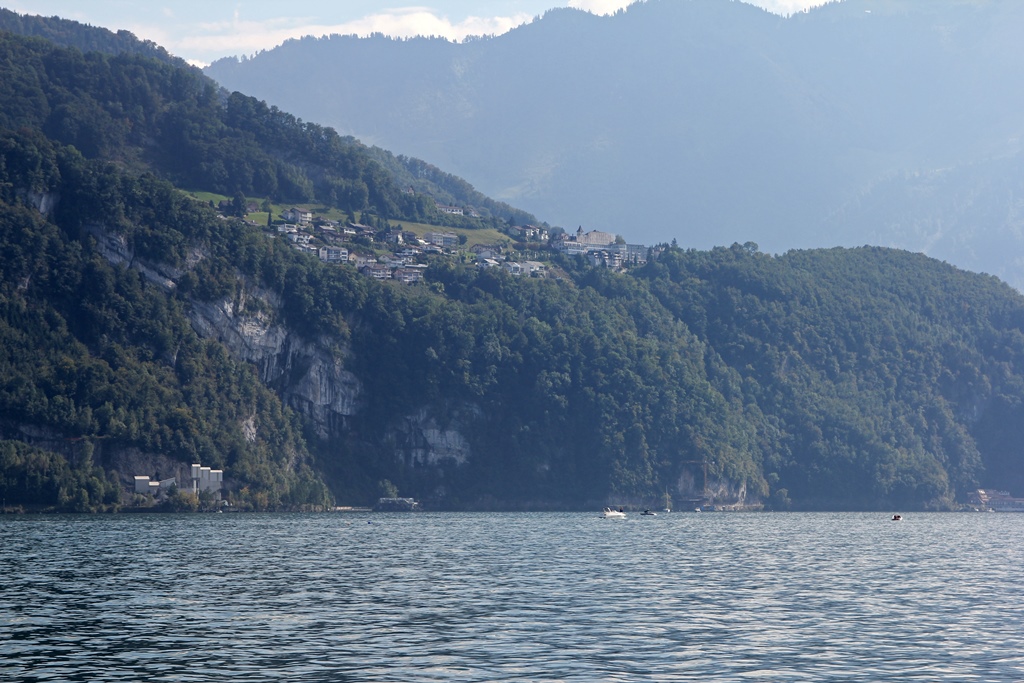
Upper Stansstad
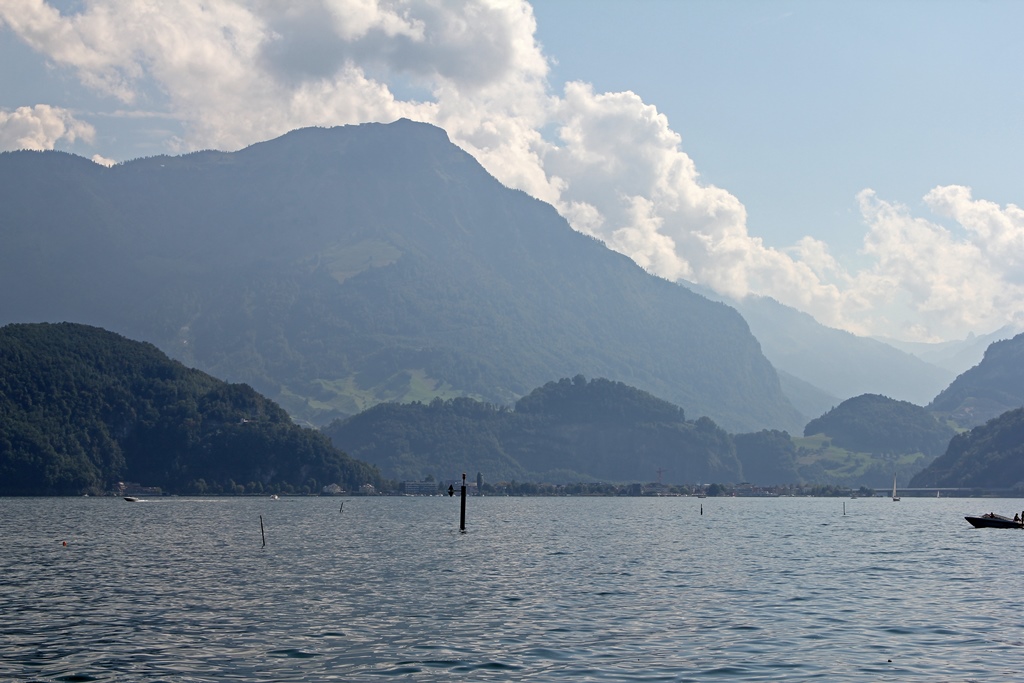
Stanser Trichter, Lower Stansstad and Stanserhorn
After crossing the Chrütztrichter, the boat actually stopped at a landing at
a town called Kastanienbaum. I'm not sure whether they were picking up or
dropping off, but we had to stay on the boat for the couple of minutes that
we were docked. There was a building at the dock that appeared to be a
hotel/restaurant. It looked nice. From the boat.
Landing at Kastanienbaum
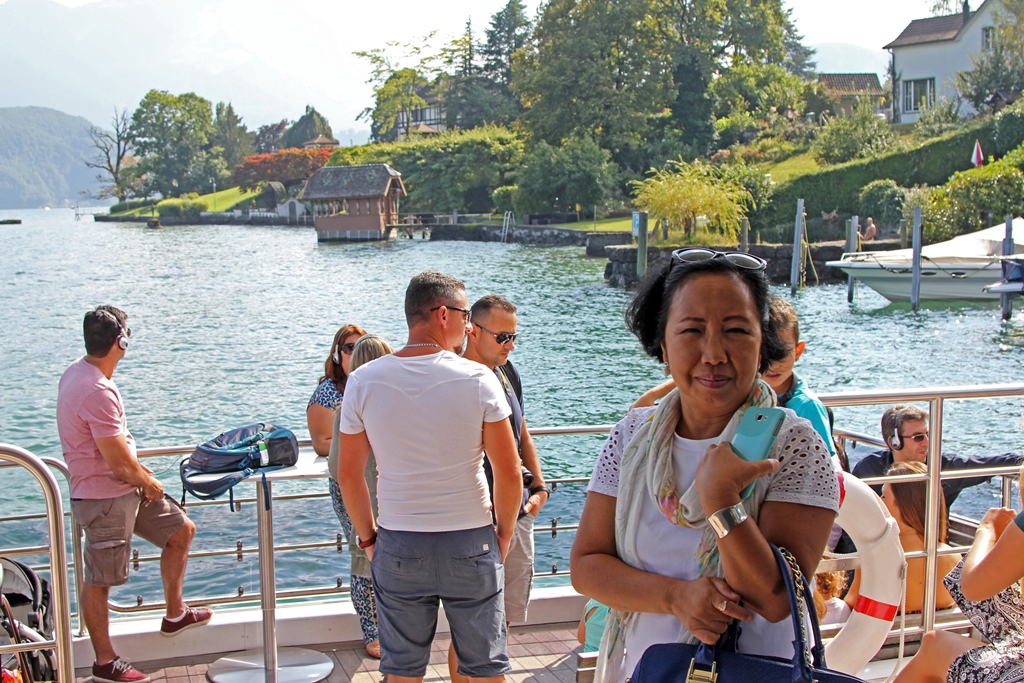
Nella at Kastanienbaum
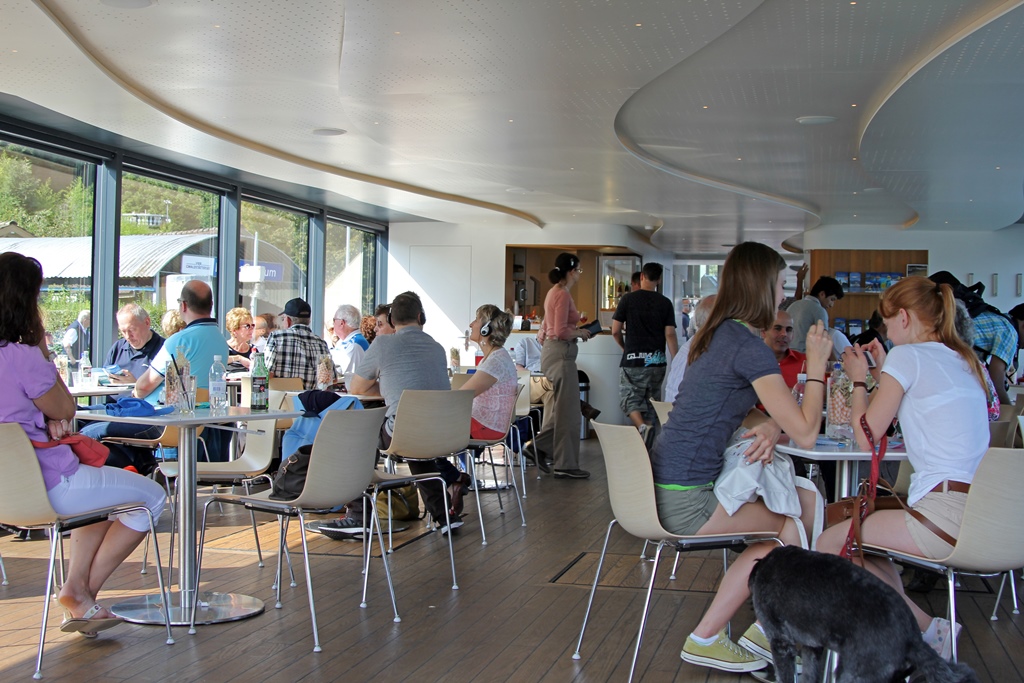
Indoors on the Boat
From Kastanienbaum we worked our way up the shoreline of the Luzernersee,
to which we'd returned. There were some quaint-looking houses and hotels,
and behind them there was another huge mountain. This one was called Pilatus,
and again was a mountain massif. Its highest peak is called the Tomlishorn,
and is nearly 7,000 feet high. Other peaks on the massif can be reached by
cogwheel railway or by cable car, or of course by hiking. Apparently Theodore
Roosevelt and Queen Victoria have made the trek.
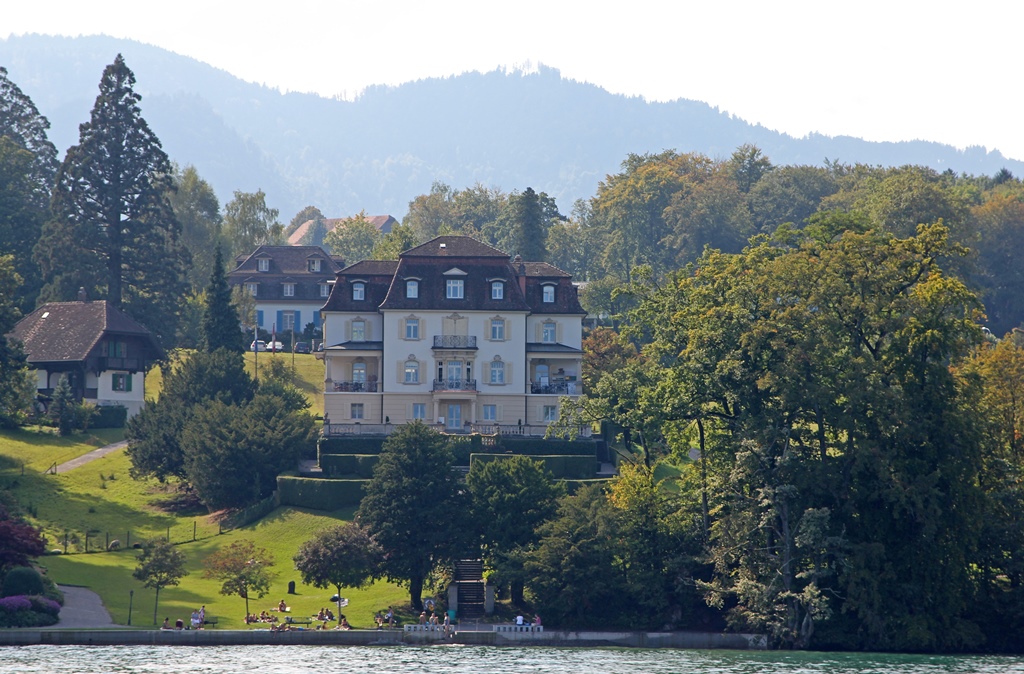
Stiftung Haus am See, Krämerstein
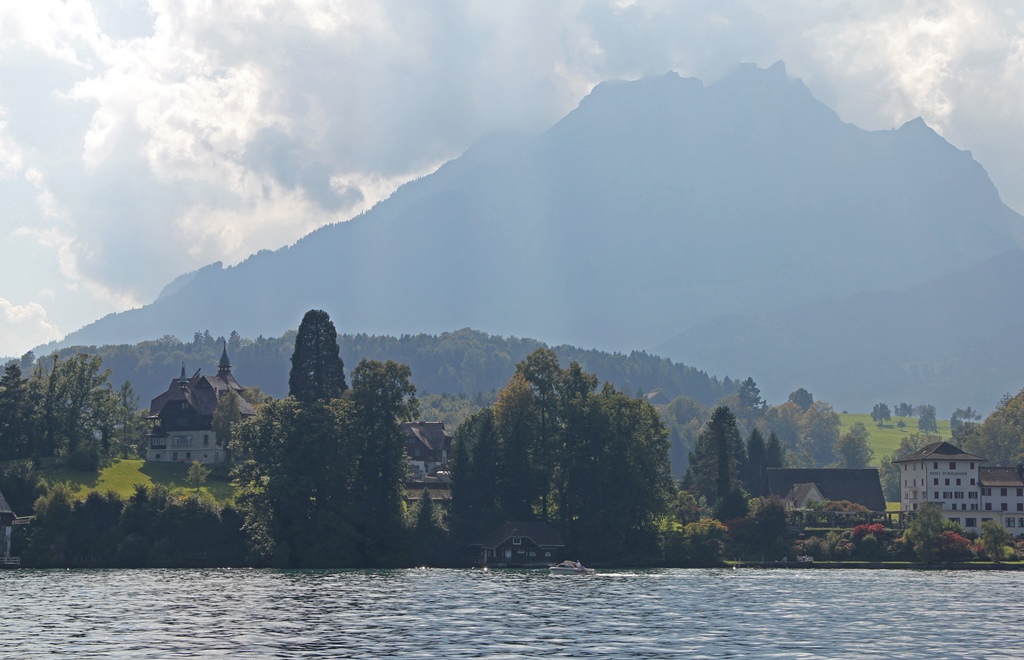
Houses, Hotel St. Niklausen and Mt. Pilatus
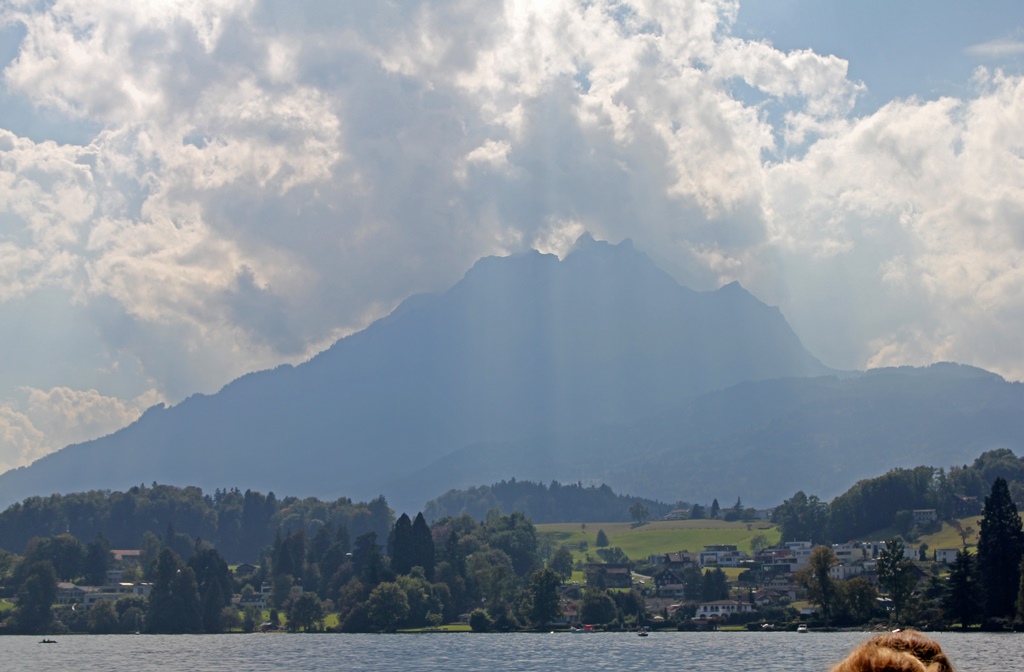
Mt. Pilatus
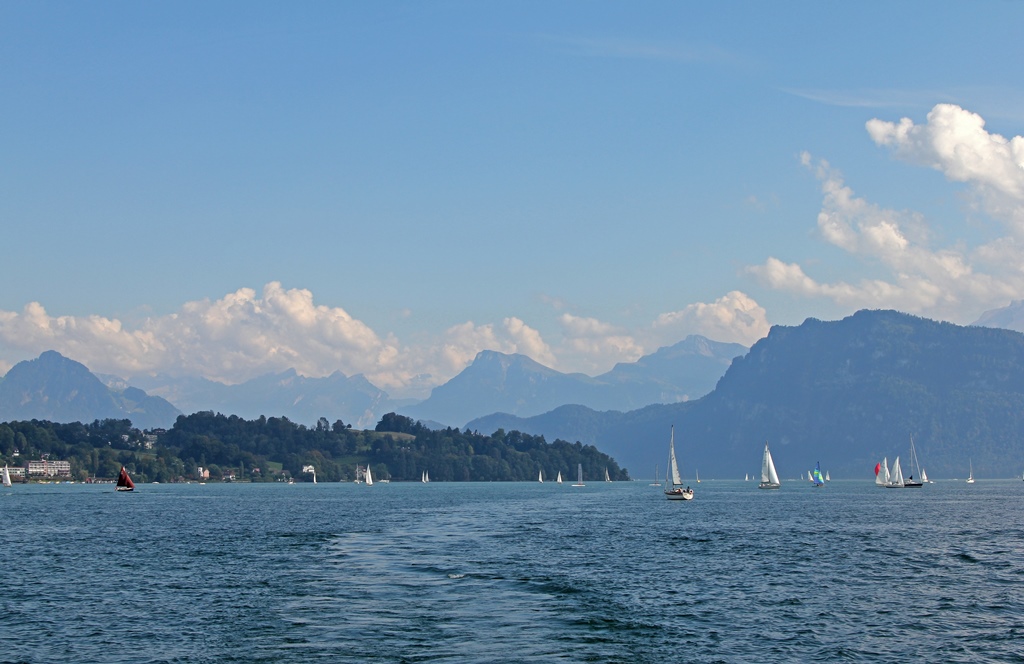
Mountains and Sailboats
Eventually we passed a marina and a park, indications that we were nearing
central Lucerne.
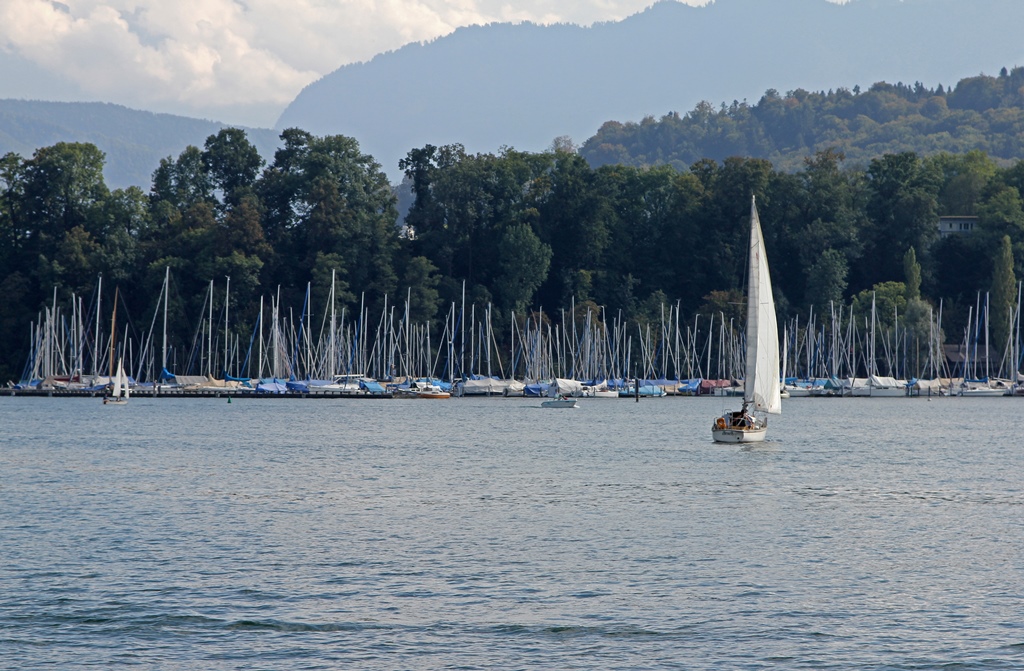
Marina Near Lucerne
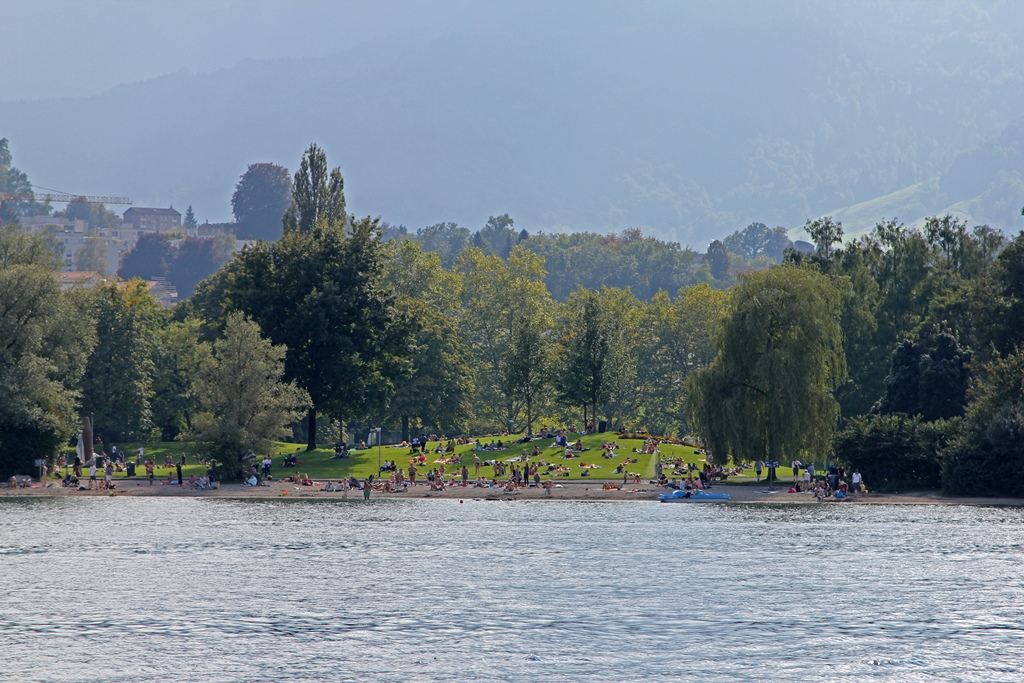
Park Near Lucerne
Then we started seeing familiar buildings, and we knew we would be returning
to dry land soon. The boat maneuvered its way in, undoubtedly complicated by
the current at the mouth of the River Reuss, and docked without incident.
Returning to Lucerne
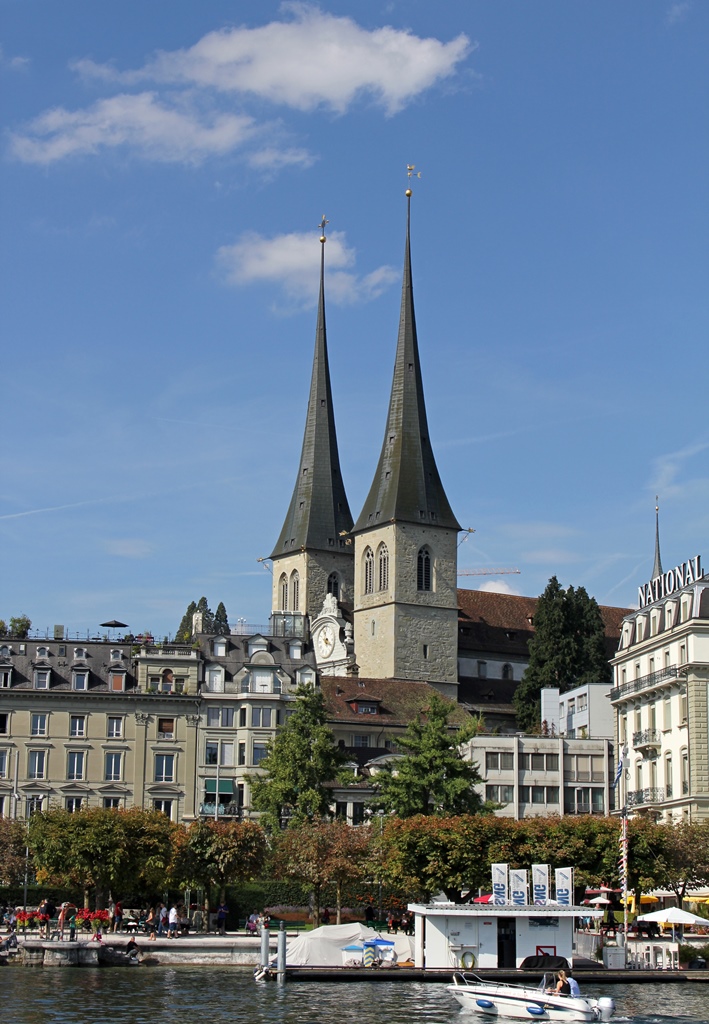
Hofkirche St. Leodegar
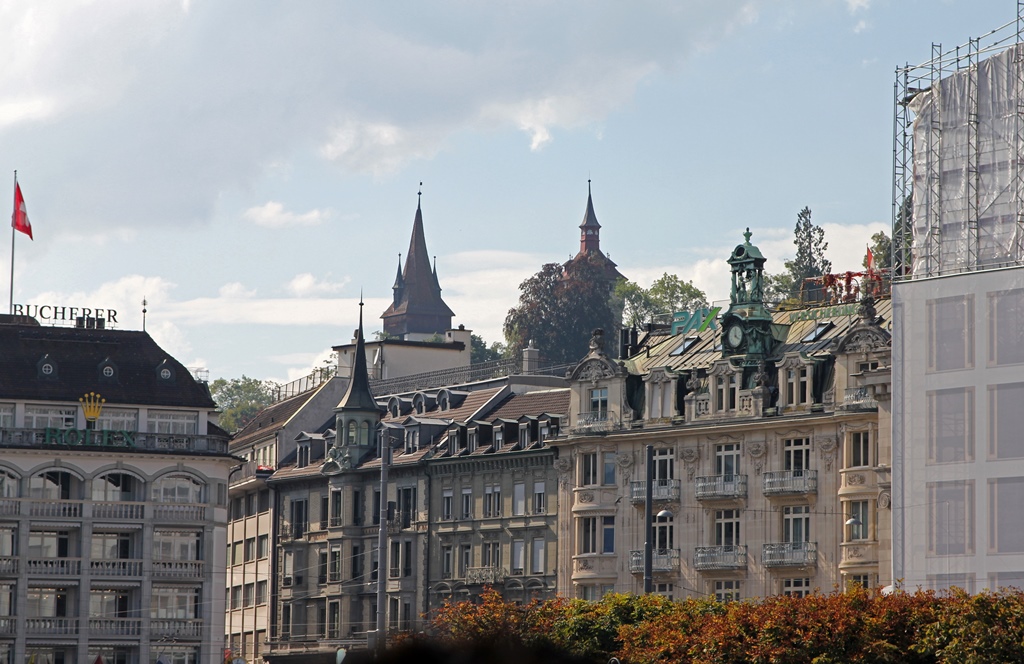
Buildings on North Bank of River Reuss
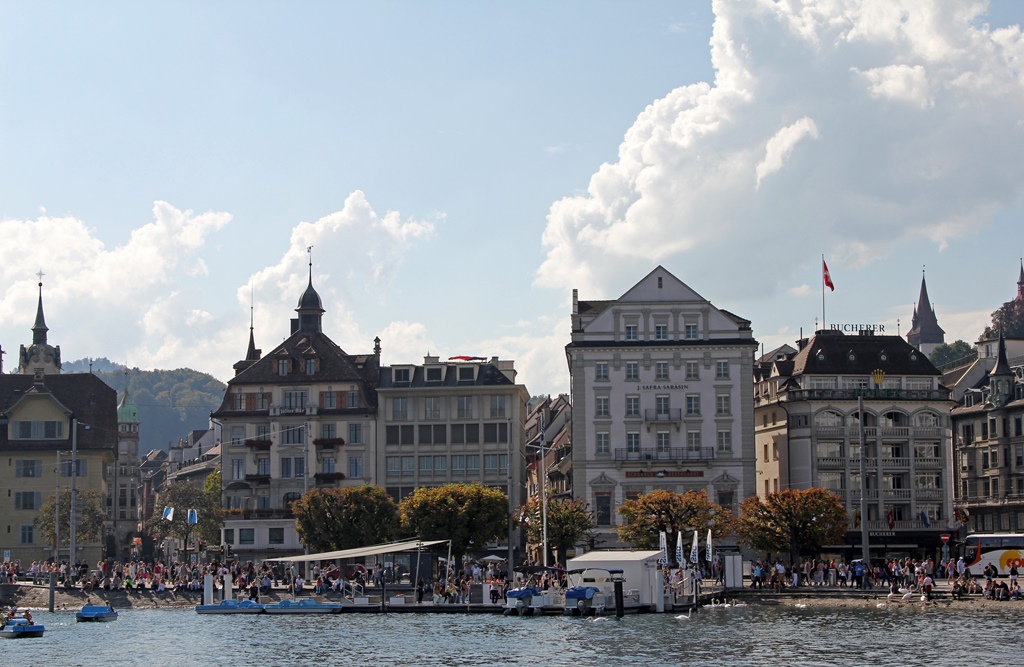
Buildings and Boat Rental on North Bank
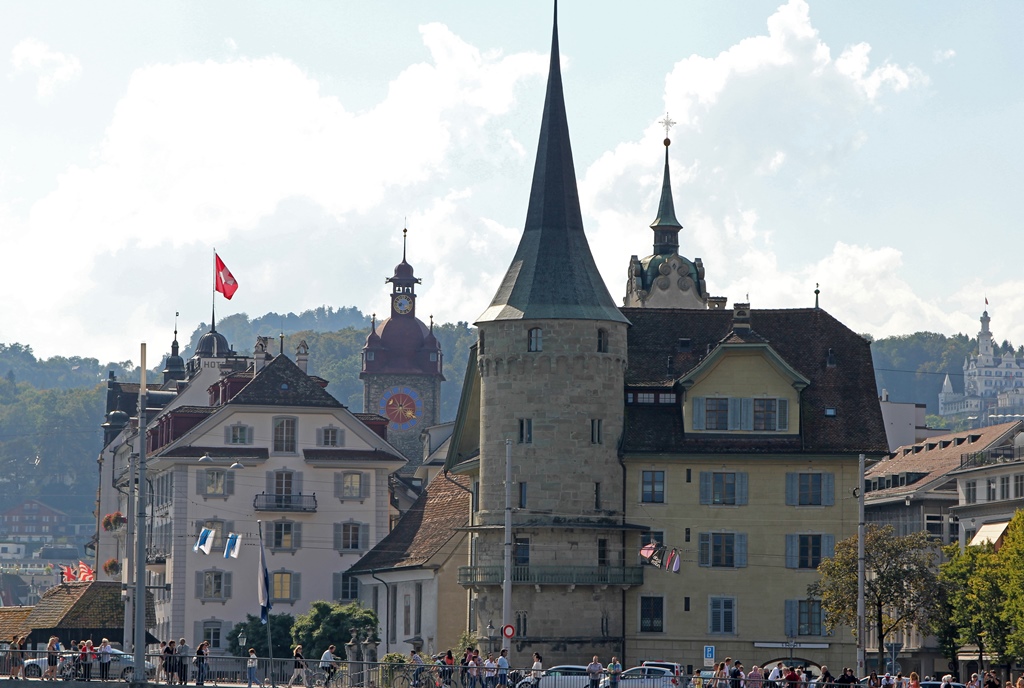
Buildings on North Bank
By this time it was starting to get late, so we returned to the train
station to catch a train back to Zürich. We had some time to browse around
the station before the train's departure, and we found some stores selling
tasty-looking stuff. We managed not to buy anything though.
Chocolate Sheets at Läderach Chocolatier
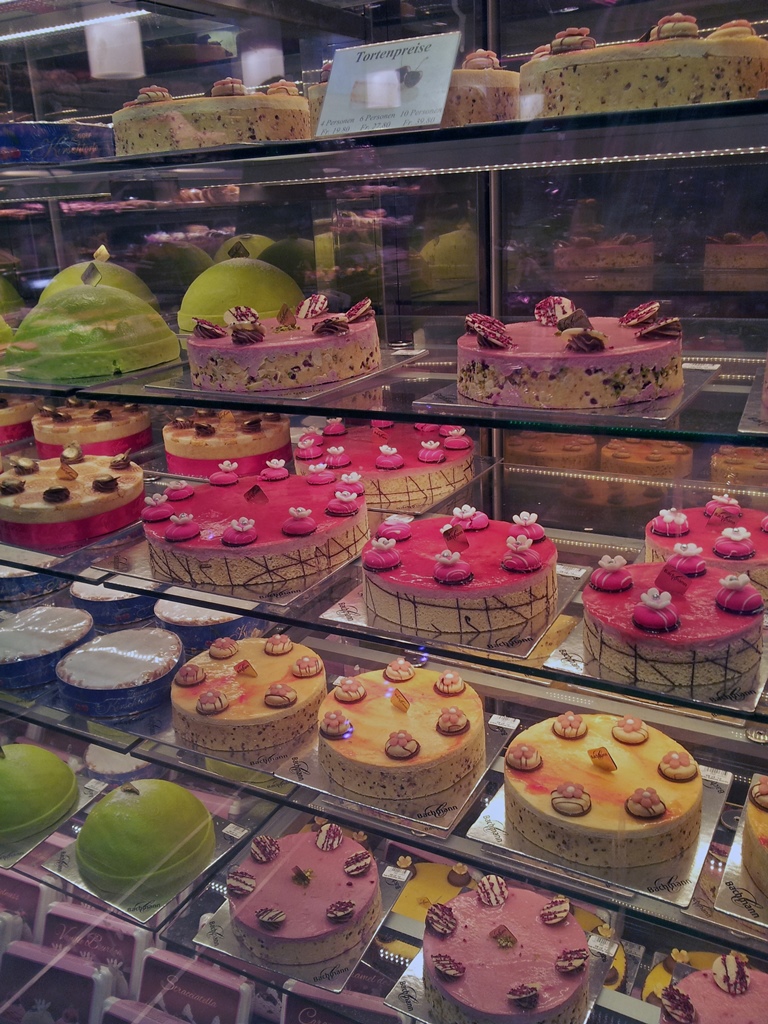
Cakes, Bachmann Bakery
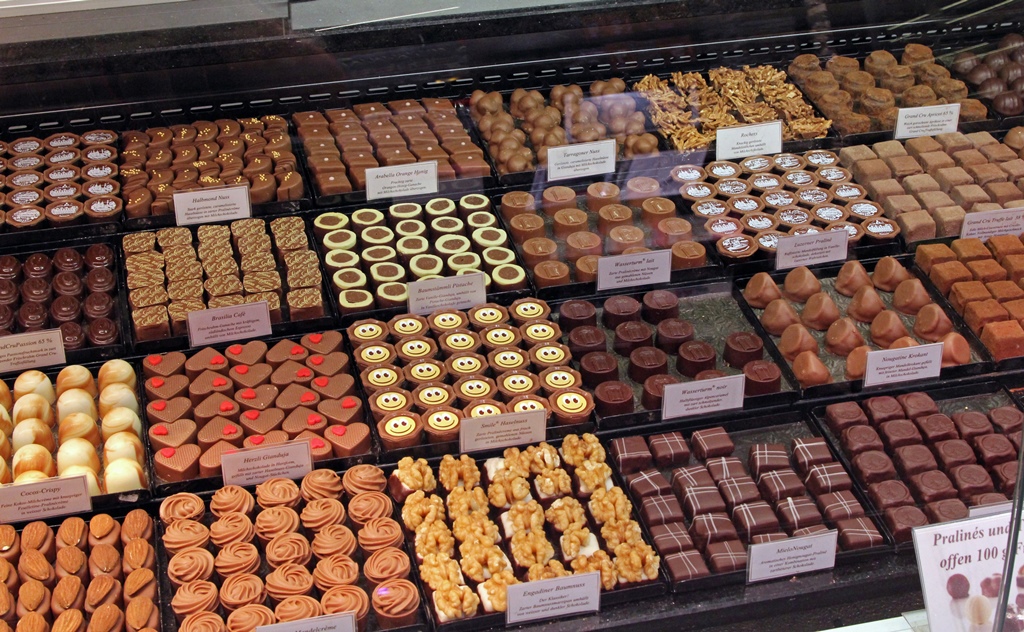
Chocolates, Bachmann Bakery
Eventually it was departure time, so we boarded the train and returned to Zürich.
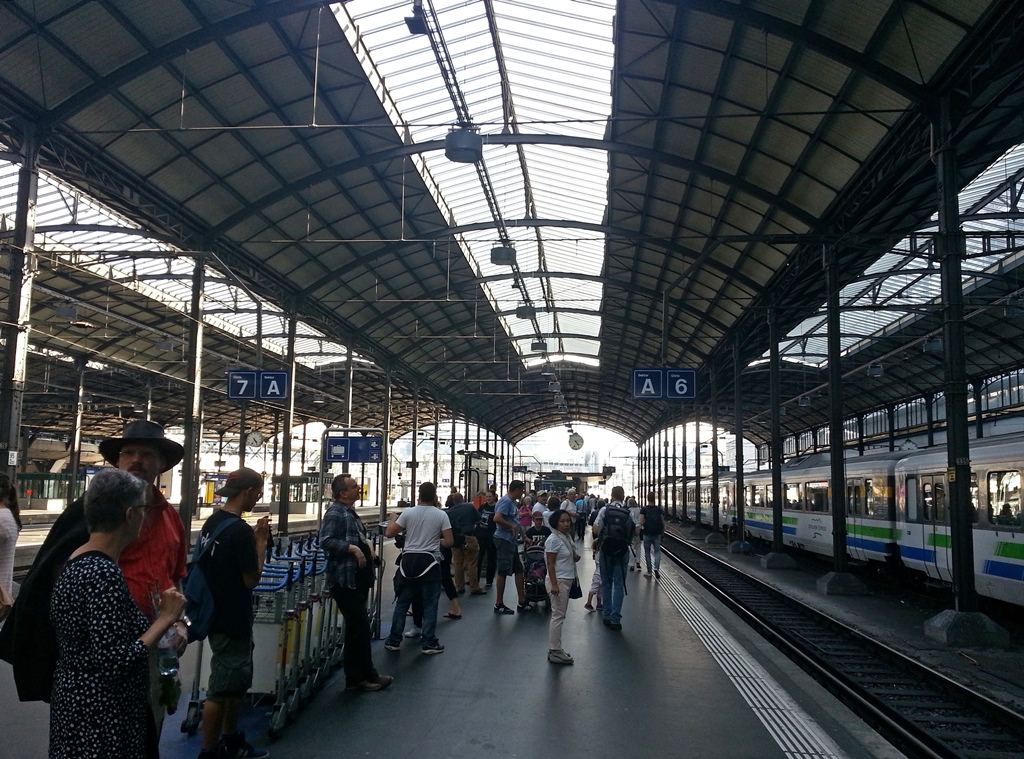
Nella Waiting for Train
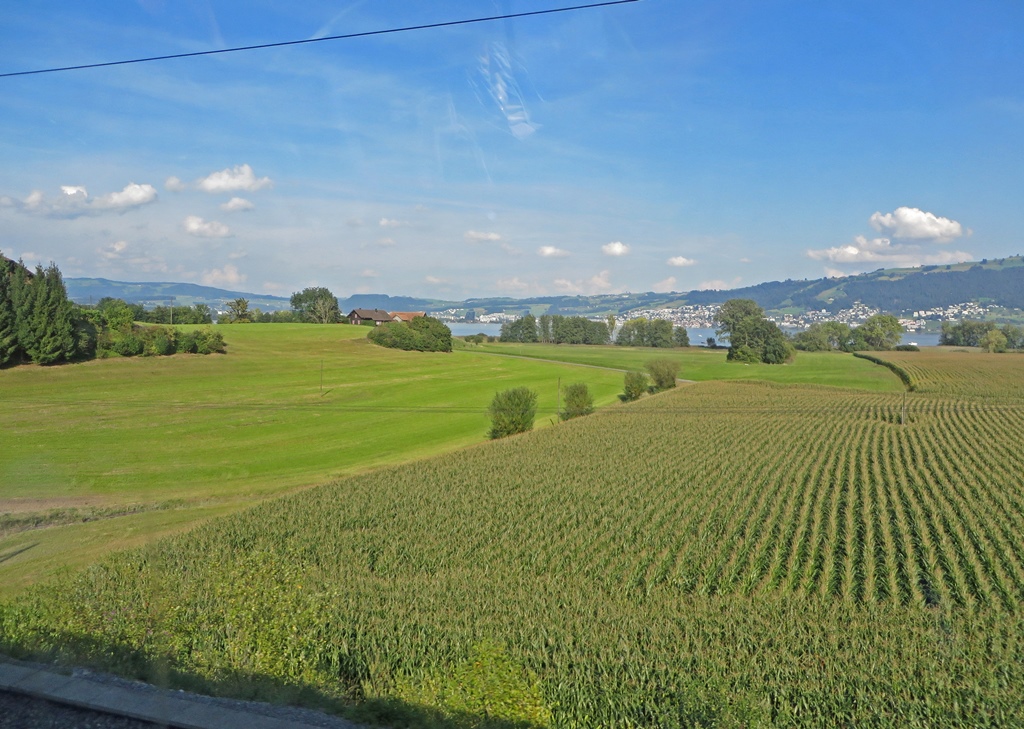
Swiss Countryside with Lake
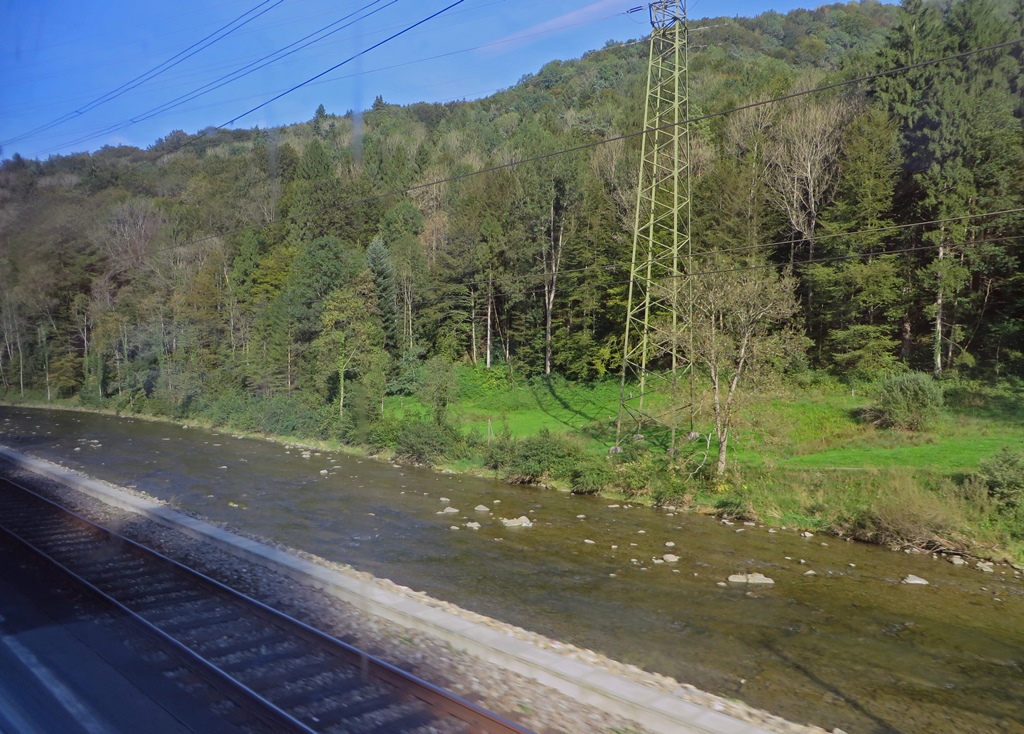
River Next to Track
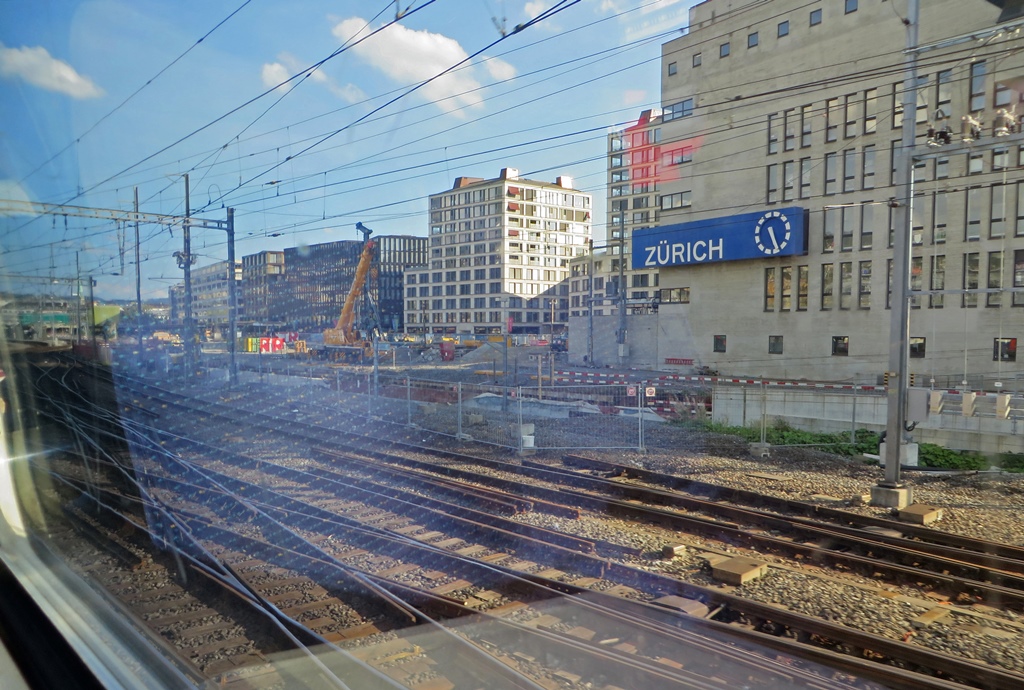
Approaching Zürich Train Station
After some rest, we started packing up, as we would be leaving Zürich the next day.
We found dinner and retired for the evening, already anticipating our next destination.
We were not yet done with Switzerland. The next day we would be heading for the
mountain wonderland of Lauterbrunnen.







